A Monte Carlo Model for WWTP Effluent Flow Treatment through Enhanced Willow Evapotranspiration
Abstract
| To enter water and not to get water |
| Foivos Delivorias, Artist |
1. Introduction
- How can actual monthly ET rates and associated effluent flow provide for irrigation purposes in a willow plantation?
- How critical is the use of willow cropping factors gathered by a specific monitoring period (four years)? Given the limited monitoring period, can a probabilistic approach be beneficial to provide naturalized monthly willow surface plantation runoff for quantifying its influence on the water quality of adjacent rivers during low natural flows?
- Can different types of datasets such as from rain gauges to remote sensing PET products support effective solutions even in small-scale environmental engineering problems?
2. Materials and Methods
2.1. Study Area
2.1.1. Monthly Rainfall Gauge and River Network Description
2.1.2. Remote Sensing PET Monthly Dataset
2.1.3. Willows Monthly Cropping Coefficients
2.2. Monte Carlo Monthly Water Balance Model Set-Up
- Monthly precipitation is input into the water balance model.
- A portion of the monthly rainfall is withdrawn as soil moisture based on the Met Éireann approach for poorly drained areas, which is summarized as follows: Soil moisture saturates on wet winter days, with water surplus drained at very slow rates, around 0.5 mm per day. The minimum Soil Moisture Deficit (SMD) is set at minus 10 mm. When SMD is greater than 10 mm, Actual Evapotranspiration (AE) is less than Potential Evapotranspiration (PE), decreasing linearly to zero when SMD reaches a theoretical maximum of 110 mm.
- Actual site runoff includes the following: (a) The monthly net proportion of rainfall minus soil moisture and minus willow actual evapotranspiration; (b) The effluent flow from WWTP, for which two scenarios have been set up associated with 500 PE, and two scenarios relevant to wastewater flows of 120 L/PE/day and 150 L/PE/day.
- Due to the high uncertainty of the willows’ monthly cropping pattern and monthly effluent flows, monthly random values based on the specified upper and lower limit monthly cropping factors and two wastewater scenarios have been set up. A total number of 100 monthly water balance models have been generated and the results are discussed below.
- The final model step refers to the exceedance probability density of the monthly plant surface runoff against low flow estimates (Q95 and Q99) at the adjacent tributary for quantifying the likelihood of the river’s quality deterioration.
3. Results
3.1. Actual Monthly Evapotranspiration Rates
3.2. Monthly Surface Runoff Rates
3.3. Actual Runoffs Withdraw Monthly Rates
3.4. Runoff Results vs. Minimum River Flow
4. Discussion
- A challenging problem in environmental engineering is the lack of long-term observations of several parameters related to a specific geoscience task. In this case, the limited information of crop monthly variation is crucial for developing a reliable modeling approach. Thus, a probabilistic Monte Carlo approach has been introduced using as random variables the monthly crop willow factors based on previous surveys in Ireland. The high uncertainty nature of these factors and their strong dependence on local meteorological conditions proves that the role of probabilistic modeling approach is necessary even though in this attempt, the probabilistic model did not consider the stochastic nature of the other meteorological variables such as rainfall and potential evapotranspiration. Future models are encouraged to use full stochastic frameworks and freely available integrated computational tools [33,34,35]. In this study, special attention has been given to Willow ET, which is a factor of local meteorological conditions, willow species, and willow management. Following a global review of 57 scientific studies across 16 countries [16] there is a clear linear regression of the water supply and Willow ET rate. The same review concludes that a critical threshold of plant density is 5 plants/m2 since for higher plant densities, ET rates are not linearly correlated.
- An important part of this study is the integration of rainfall gauge records along with PET remote sensing dataset in real world problems. Potential Evapotranspiration remains a challenging meteorological variable even in countries with advanced meteorological networks like Ireland. The recent advantages of using recent PET remote sensing dataset [36] could provide benefits in several tasks of geosciences as the “Electronic Age” offers new and attractive opportunities to hydrologists for remote sensing (RS) of hydrological data [37] as well as offers perspectives in the domain of forest hydrology [38]. In this study, the use of a recent remote sensing PET dataset in a small-scale model highlights its benefit for further use in other geoscience disciplines.
- The idea of the expansion of the paradigm on a national scale appears to be attractive and will benefit Irish environmental biodiversity which is key for National Policy [41], recognizing the vital role of ecological engineering in the design of sustainable ecosystems that integrate human society with its natural environment for the benefit of both [42].
- The natural WWTP treatment systems appear to be attractive, efficient, and low-cost solutions [43,44]. In conjunction with modern water reuse options [45], they could especially benefit decentralized communities by decreasing the pressure in natural water bodies. Monte Carlo approaches seem to be very promising in dealing with multiple uncertainty environmental engineering problems [46].
5. Conclusions
Funding
Data Availability Statement
Acknowledgments
Conflicts of Interest
References
- Zsuffa, L.; Mosseler, A.; Raj, Y. Ecology and Management of Forest Biomass Production Systems; Perttu, K.L., Ed.; Swedish University of Agricultural Sciences: Uppsala, Sweden, 1984; pp. 261–281. [Google Scholar]
- Gullberg, U. Towards making willows pilot species for coppicing production. For. Chron. 1993, 69, 721–726. [Google Scholar] [CrossRef]
- Volk, T.A.; Abrahamson, L.P.; Nowak, C.A.; Smart, L.B.; Tharakan, P.J.; White, E.H. The development of short-rotation willow in the northeastern United States for bioenergy and bioproducts, agroforestry and phytoremediation. Biomass Bioenergy 2006, 30, 715–727. [Google Scholar] [CrossRef]
- Guidi, W.; Pitre, F.E.; Labrecque, M. Short-rotation coppice of willows for the 689 production of biomass in eastern Canada. In Biomass Now-Sustainable Growth and Use; IntechOpen: London, UK, 2013. [Google Scholar]
- Lachapelle-T, X.; Labrecque, M.; Comeau, Y. Treatment and valorization of a primary municipal wastewater by a short rotation willow coppice vegetation filter. Ecol. Eng. 2019, 130, 32–44. [Google Scholar] [CrossRef]
- Dimitriou, I.; Rosenqvist, H. Sewage sludge and wastewater fertilisation of Short Rotation Coppice (SRC) for increased bioenergy production—Biological and economic potential. Biomass Bioenergy 2011, 35, 835–842. [Google Scholar] [CrossRef]
- Duggan, J. The potential for landfill leachate treatment using willows in the UK—A critical review. Resour. Conserv. Recycl. 2005, 45, 97–113. [Google Scholar] [CrossRef]
- Rüth, B.; Lennartz, B.; Kahle, P. Water regime of mechanical—Biological pretreated waste materials under fast-growing trees. Waste Manag. Res. 2007, 25, 408–416. [Google Scholar] [CrossRef] [PubMed]
- Mirck, J.; Volk, T.A. Seasonal sap flow of four Salix varieties growing on the Solvay wastebeds in Syracuse, NY, USA. Int. J. Phytoremediat 2009, 12, 1–23. [Google Scholar] [CrossRef]
- Witters, N.; Van Slycken, S.; Ruttens, A.; Adriaensen, K.; Meers, E.; Meiresonne, L.; Filip, M.G.; Tack, T.T.; Laes, E.; Vangronsveld, J. Short-rotation coppice of willow for phytoremediation of a metal-contaminated agricultural area: A sustainability assessment. BioEnergy Res. 2009, 2, 144–152. [Google Scholar] [CrossRef]
- Grenier, V.; Pitre, F.E.; Nissim, W.G.; Labrecque, M. Genotypic differences explain most of the response of willow cultivars to petroleum-contaminated soil. Trees 2015, 29, 871–881. [Google Scholar] [CrossRef]
- Gregersen, P.; Brix, H. Zero-discharge of nutrients and water in a willow dominated constructed wetland. Water Sci. Technol. 2001, 44, 407–412. [Google Scholar] [CrossRef]
- Curneen, S.J.; Gill, L.W. A comparison of the suitability of different willow varieties to treat on-site wastewater effluent in an Irish climate. J. Environ. Manag. 2014, 133, 153–161. [Google Scholar] [CrossRef] [PubMed]
- Hénault-Ethier, L.; Gomes, M.P.; Lucotte, M.; Smedbol, É.; Maccario, S.; Lepage, L.; Juneau, P.; Labrecque, M. High yields of riparian buffer strips planted with Salix miyabena ‘SX64’along field crops in Québec, Canada. Biomass Bioenergy 2017, 105, 219–229. [Google Scholar] [CrossRef]
- Yoder, K.S.; Moser, B.C. 696 (PS 5) pussy willow branches—A new crop for 888 sustainable agriculture. Hort. Sci. 1993, 28, 551. [Google Scholar]
- Frédette, C.; Labrecque, M.; Comeau, Y.; Brisson, J. Willows for environmental projects: A literature review of results on evapotranspiration rate and its driving factors across the genus Salix. J. Environ. Manag. 2019, 246, 526–537. [Google Scholar] [CrossRef]
- McMahon, T.A.; Finlayson, B.L.; Peel, M.C. Historical developments of models for estimating evaporation using standard meteorological data. Water 2016, 3, 788–818. [Google Scholar] [CrossRef]
- Tegos, A.; Malamos, N.; Koutsoyiannis, D. A parsimonious regional parametric evapotranspiration model based on a simplification of the Penman–Monteith formula. J. Hydrol. 2015, 524, 708–717. [Google Scholar] [CrossRef]
- Tegos, A.; Malamos, N.; Efstratiadis, A.; Tsoukalas, I.; Karanasios, A.; Koutsoyiannis, D. Parametric modelling of potential evapotranspiration: A global survey. Water 2017, 9, 795. [Google Scholar] [CrossRef]
- Curneen, S. An Assessment of the Performance of Willow Evapotranspiration Systems for the Treatment of On-Site Wastewater in Ireland. Doctoral Dissertation, Trinity College Dublin, Dublin, Ireland, 2014. [Google Scholar]
- Vicente-Serrano, S.M.; Domínguez-Castro, F.; Murphy, C.; Hannaford, J.; Reig, F.; Peña-Angulo, D.; Tramblay, Y.; Trigo, R.M.; MacDonald, N.; El Kenawy, A.; et al. Long-term variability and trends in meteorological droughts in Western Europe (1851–2018). Int. J. Climatol. 2021, 41, E690–E717. [Google Scholar] [CrossRef]
- Noone, S.; Broderick, C.; Duffy, C.; Matthews, T.K.; Wilby, R.L.; Murphy, C. A 250 year drought catalogue for the island of Ireland (1765-2015). Int. J. Climatol. 2017, 37, 239–254. [Google Scholar] [CrossRef]
- Tegos, A.; Cody, J. Recent insights in developing Standardized-Precipitation-Evapotranspiration index and 152-years drought assessment for Dublin area (1850–2022). In Proceedings of the Irish National Hydrology Conference, Tullamore, Ireland, 14 November 2023. [Google Scholar]
- Tegos, A.; Schlüter, W.; Gibbons, N.; Katselis, Y.; Efstratiadis, A. Assessment of environmental flows from complexity to parsimony—Lessons from Lesotho. Water 2018, 10, 1293. [Google Scholar] [CrossRef]
- Oswald Spring, Ú.; Oswald Spring, Ú. The Nexus among Water, Soil, Food, Biodiversity and Energy Security. In Earth at Risk in the 21st Century: Rethinking Peace, Environment, Gender, and Human, Water, Health, Food, Energy Security, and Migration: With a Foreword by Lourdes Arizpe Schlosser and a Preface by Hans Günter Brauch; Springer: Cham, Switzerland, 2020; pp. 543–578. [Google Scholar]
- Dimitriadis, P.; Tegos, A.; Koutsoyiannis, D. Stochastic analysis of hourly to monthly potential evapotranspiration with a focus on the long-range dependence and application with reanalysis and ground-station data. Hydrology 2021, 8, 177. [Google Scholar] [CrossRef]
- Asfaw, D.T.; Singer, M.B.; Rosolem, R.; MacLeod, D.; Cuthbert, M.; Miguitama, E.Q.; Gaona, M.F.R.; Michaelides, K. stoPET v1. 0: A stochastic potential evapotranspiration generator for simulation of climate change impacts. Geosci. Model. Dev. Discuss. 2023, 16, 557–571. [Google Scholar] [CrossRef]
- Long, T.; Wang, D.; Wu, X.; Chen, X.; Huang, Z. Simulation of Irrigation Strategy Based on Stochastic Rainfall and Evapotranspiration. Agronomy 2023, 13, 2849. [Google Scholar] [CrossRef]
- Koutsoyiannis, D. HESS Opinions “A random walk on water”. Hydrol. Earth Syst. Sci. 2010, 14, 585–601. [Google Scholar] [CrossRef]
- Bree, T. Flow Duration Curves for Ungauged Catchments in Ireland; EPA: Washington, DC, US, 2018.
- Tegos, A.; Malamos, N.; Koutsoyiannis, D. Raspotion—A new global PET dataset by means of remote monthly temperature data and parametric modelling. Hydrology 2022, 9, 32. [Google Scholar] [CrossRef]
- Hooker, J.; Duveiller, G.; Cescatti, A. A global dataset of air temperature derived from satellite remote sensing and weather stations. Sci. Data 2018, 5, 1–11. [Google Scholar] [CrossRef]
- Francesco, C.; Papalexiou, S.M.; Markonis, Y.; Grimaldi, S. PyCoSMoS: An advanced toolbox for simulating real-world hydroclimatic data. Environ. Model. Softw. 2024, 178, 106076. [Google Scholar] [CrossRef]
- Efstratiadis, A.; Dialynas, Y.G.; Kozanis, S.; Koutsoyiannis, D. A multivariate stochastic model for the generation of synthetic time series at multiple time scales reproducing long-term persistence. Environ. Model. Softw. 2014, 62, 139–152. [Google Scholar] [CrossRef]
- Tsoukalas, I.; Kossieris, P.; Makropoulos, C. Simulation of non-Gaussian correlated random variables, stochastic processes and random fields: Introducing the anySim R-Package for environmental applications and beyond. Water 2020, 12, 1645. [Google Scholar] [CrossRef]
- Bhattarai, N.; Wagle, P. Recent Advances in Remote Sensing of Evapotranspiration. Remote Sens. 2021, 13, 4260. [Google Scholar] [CrossRef]
- Schultz, G.A. Remote sensing in hydrology. J. Hydrol. 1988, 100, 239–265. [Google Scholar] [CrossRef]
- Stewart, J.B.; Finch, J.W. Application of remote sensing to forest hydrology. J. Hydrol. 1993, 150, 701–716. [Google Scholar] [CrossRef]
- Mohanty, B.P.; Cosh, M.H.; Lakshmi, V.; Montzka, C. Soil moisture remote sensing: State-of-the-science. Vadose Zone J. 2017, 16, 1–9. [Google Scholar] [CrossRef]
- Brocca, L.; Ciabatta, L.; Massari, C.; Camici, S.; Tarpanelli, A. Soil moisture for hydrological applications: Open questions and new opportunities. Water 2017, 9, 140. [Google Scholar] [CrossRef]
- Morrison, R.; Bullock, C. A National Biodiversity Expenditure Review for Ireland; University College Dublin: Dublin, Ireland, 2018. [Google Scholar]
- Mitsch, W.J.; Jørgensen, S.E. Ecological engineering: A field whose time has come. Ecol. Eng. 2003, 20, 363–377. [Google Scholar] [CrossRef]
- Knight, R.; McKim, T.W.; Kohl, H.R. Performance of a natural wetland treatment system for wastewater management. J. (Water Pollut. Control Fed.) 1987, 59, 746–754. [Google Scholar]
- Brissaud, F. Low technology systems for wastewater treatment: Perspectives. Water Sci. Technol. 2007, 55, 1–9. [Google Scholar] [CrossRef] [PubMed][Green Version]
- Makropoulos, C.; Rozos, E.; Tsoukalas, I.; Plevri, A.; Karakatsanis, G.; Karagiannidis, L.; Makri, E.; Lioumis, C.; Noutsopoulos, C.; Mamais, D.; et al. Sewer-mining: A water reuse option supporting circular economy, public service provision and entrepreneurship. J. Environ. Manag. 2018, 216, 285–298. [Google Scholar] [CrossRef]
- Psarrou, E.; Tsoukalas, I.; Makropoulos, C. A Monte-Carlo-based method for the optimal placement and operation scheduling of sewer mining units in urban wastewater networks. Water 2018, 10, 200. [Google Scholar] [CrossRef]
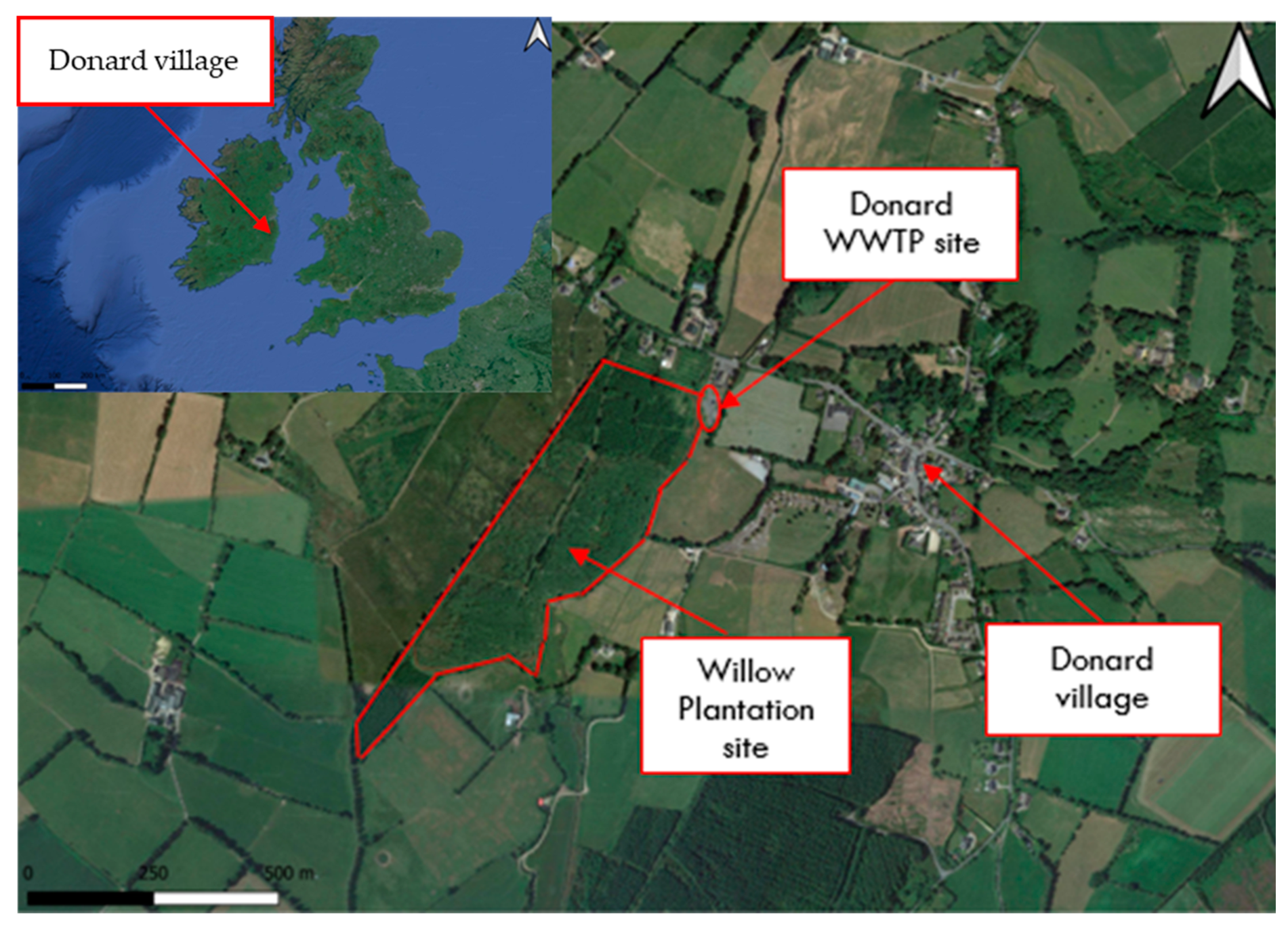

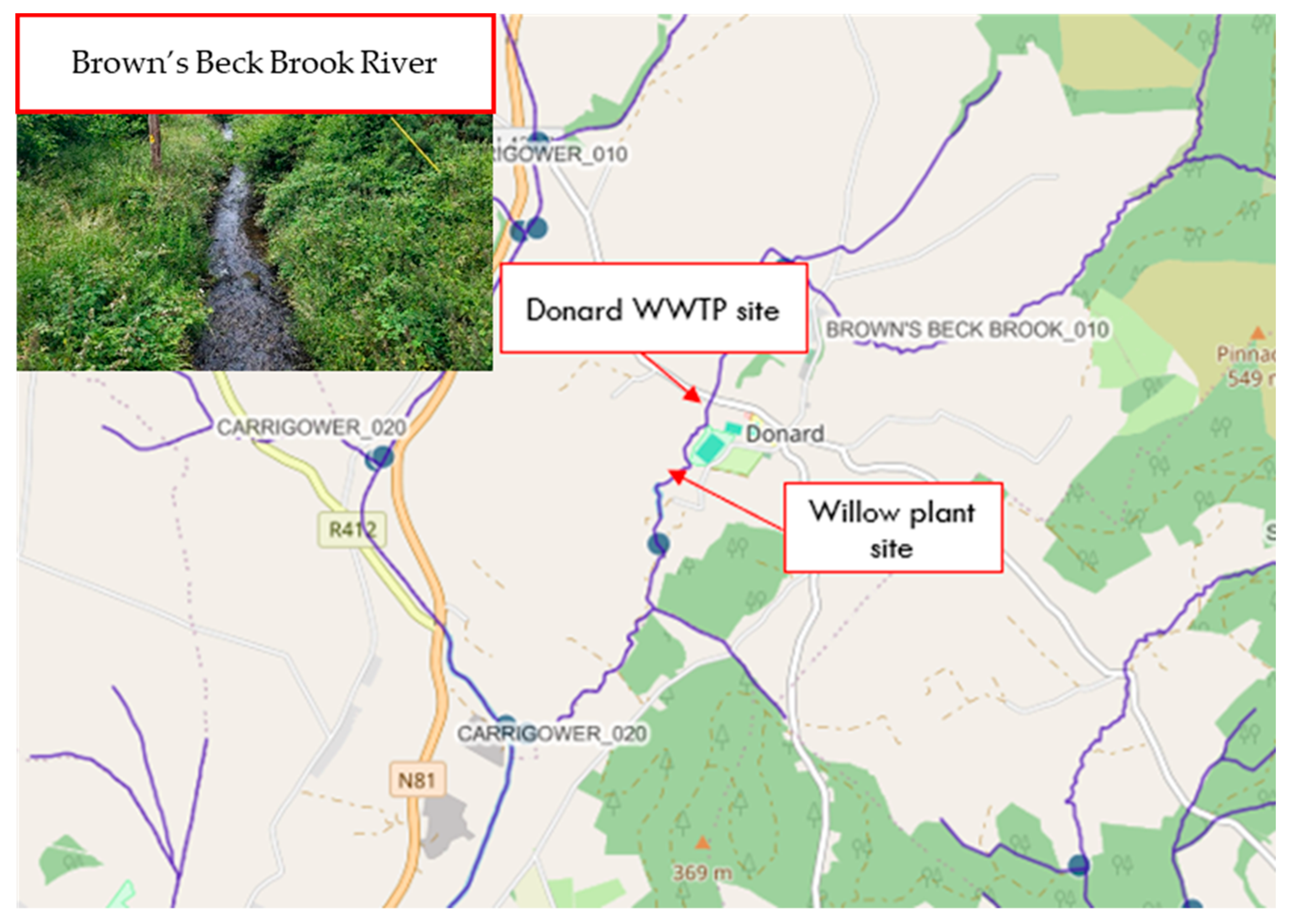
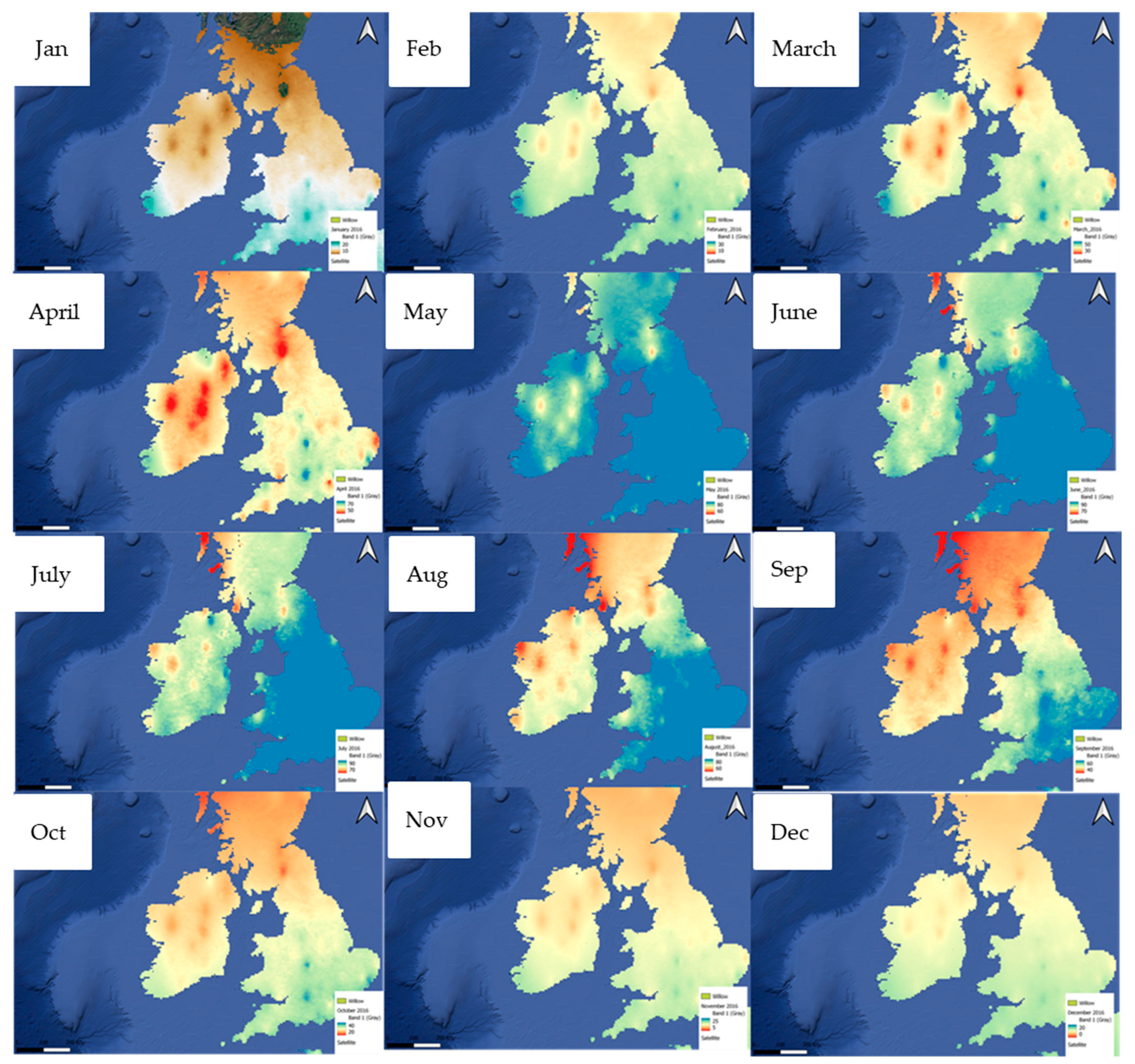
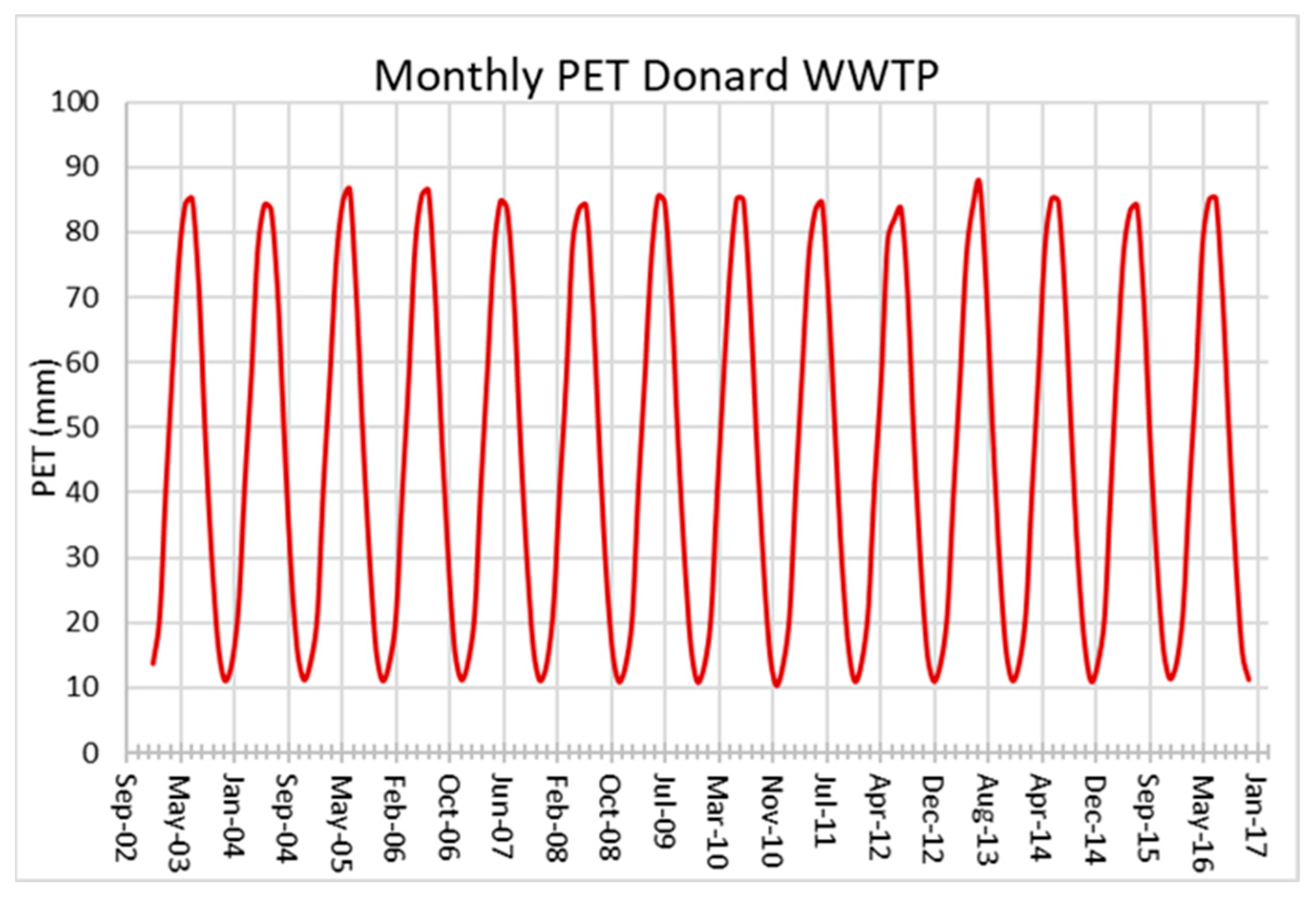
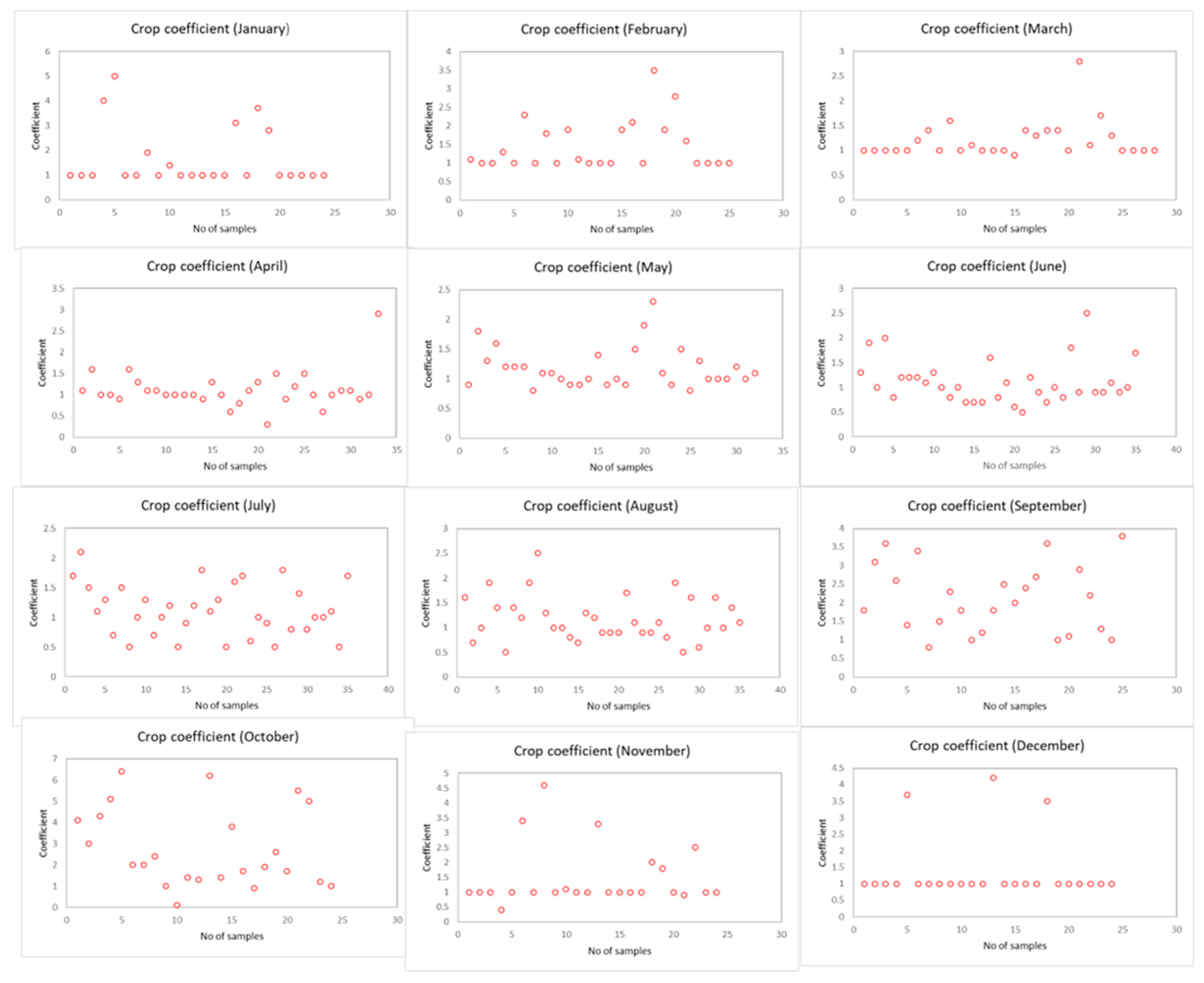
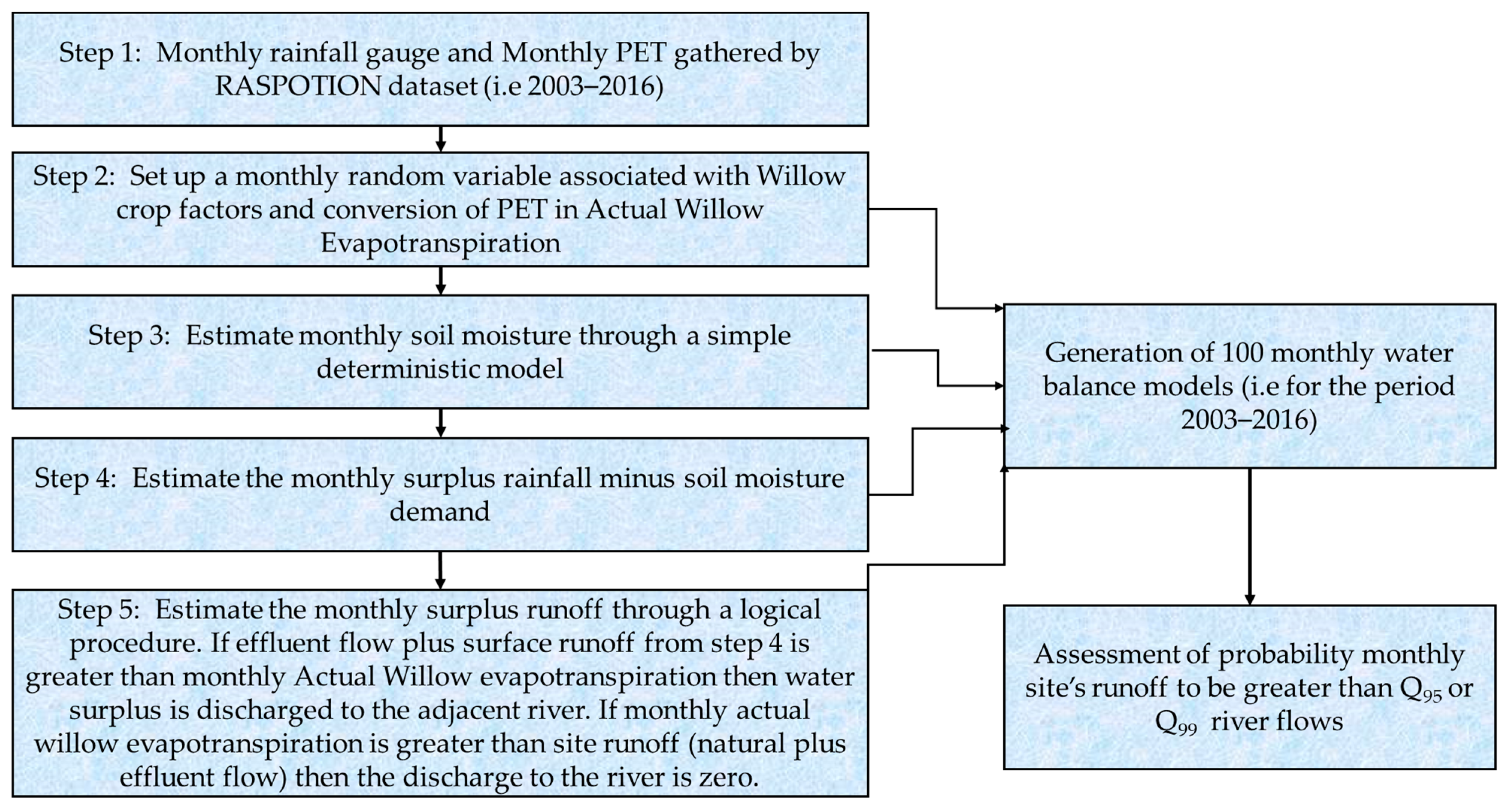
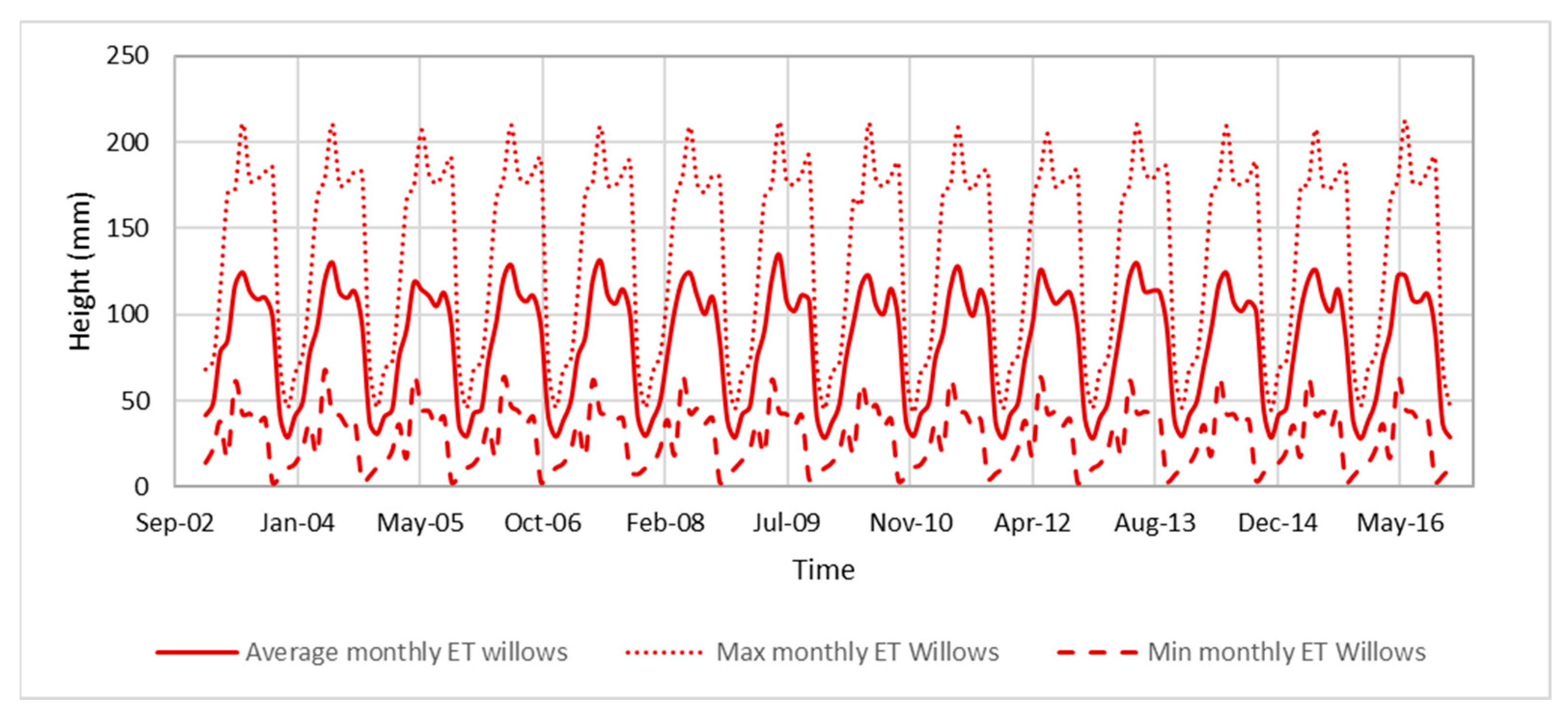
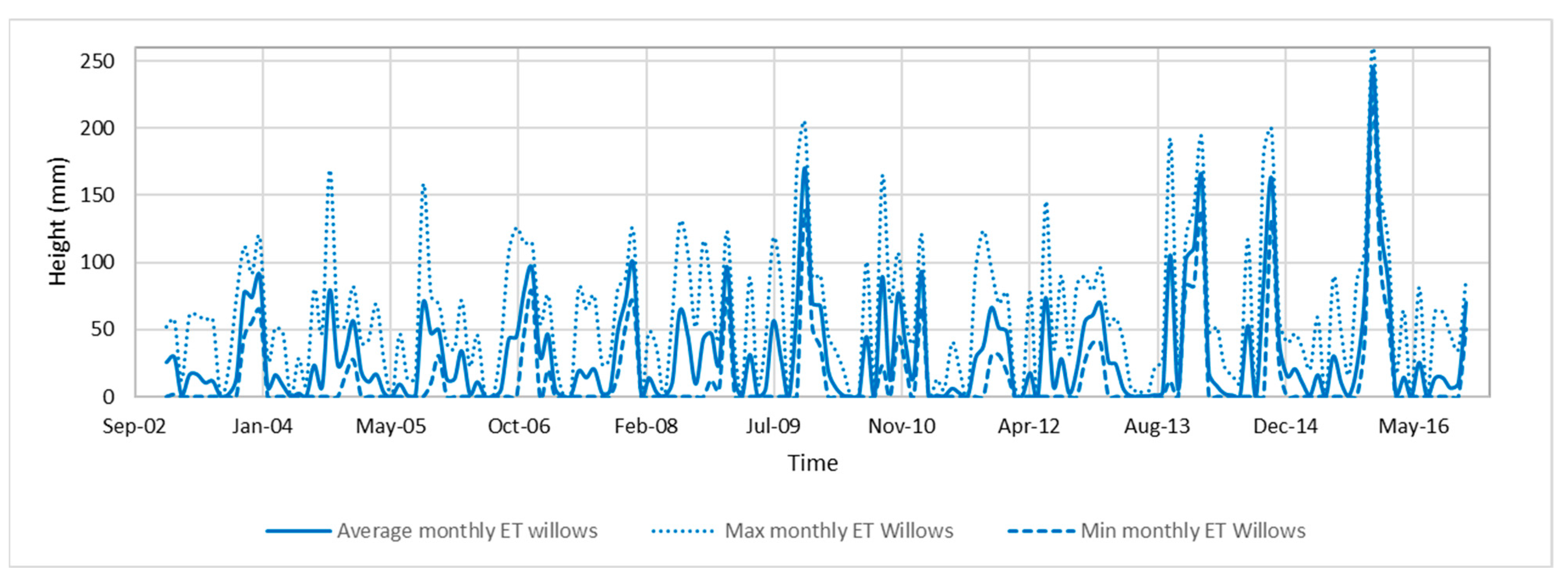
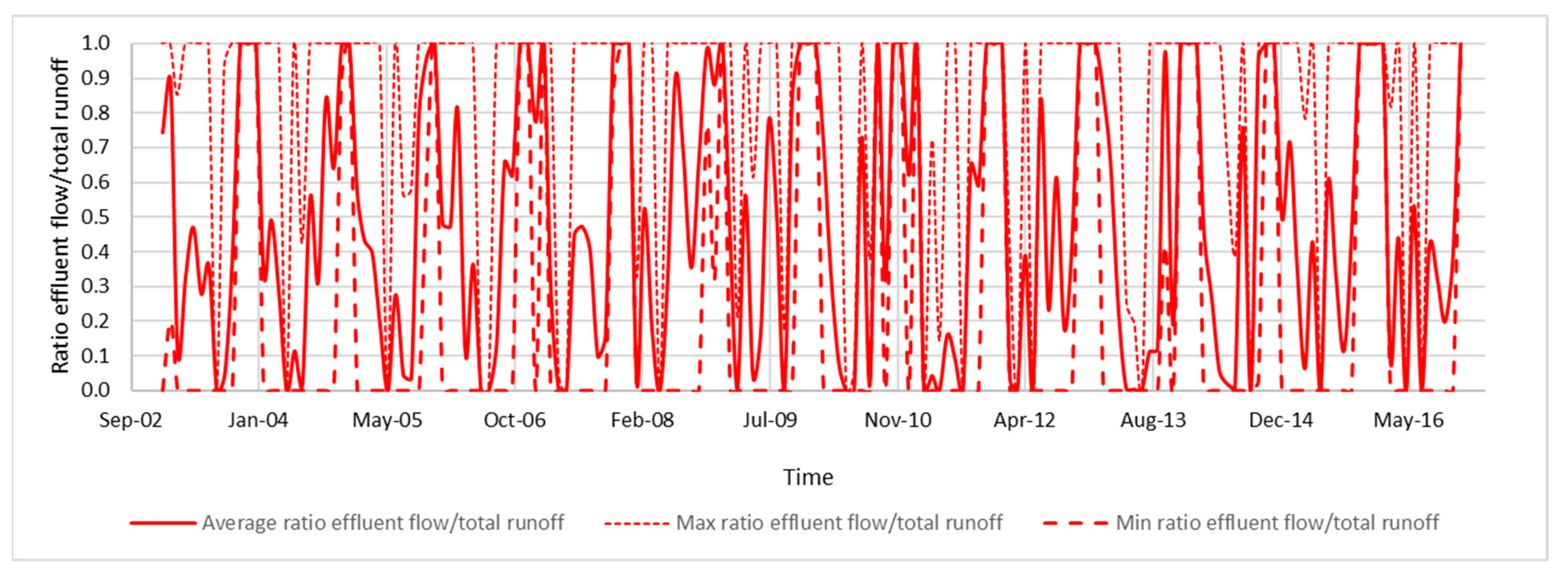
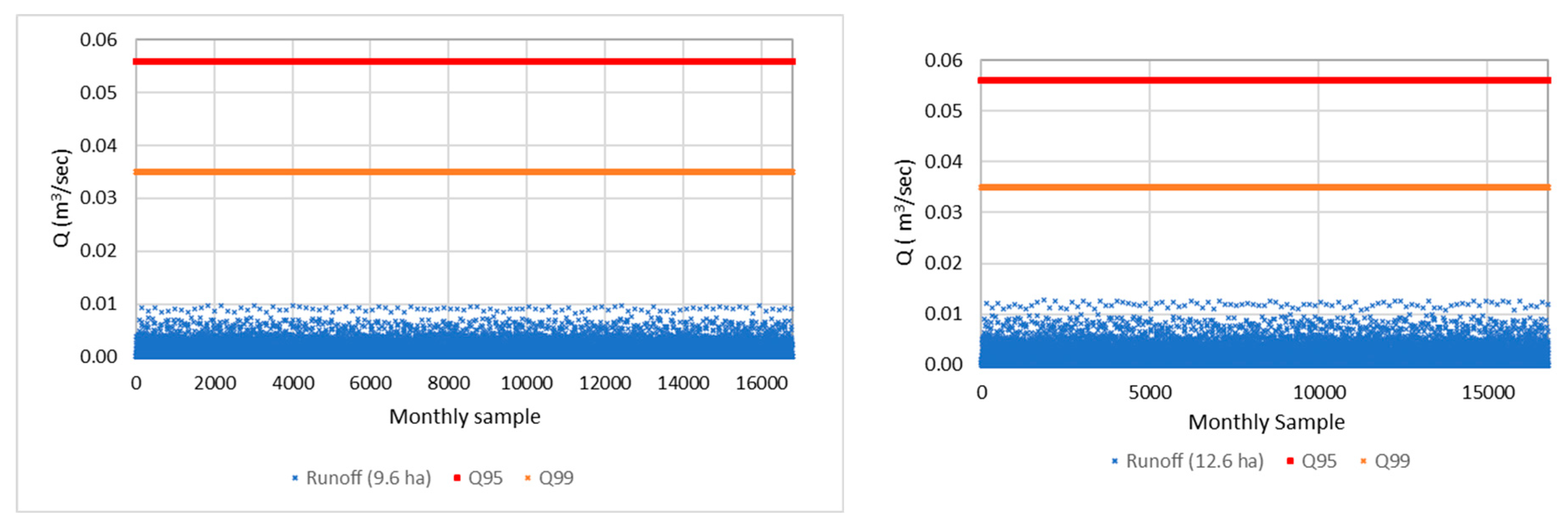
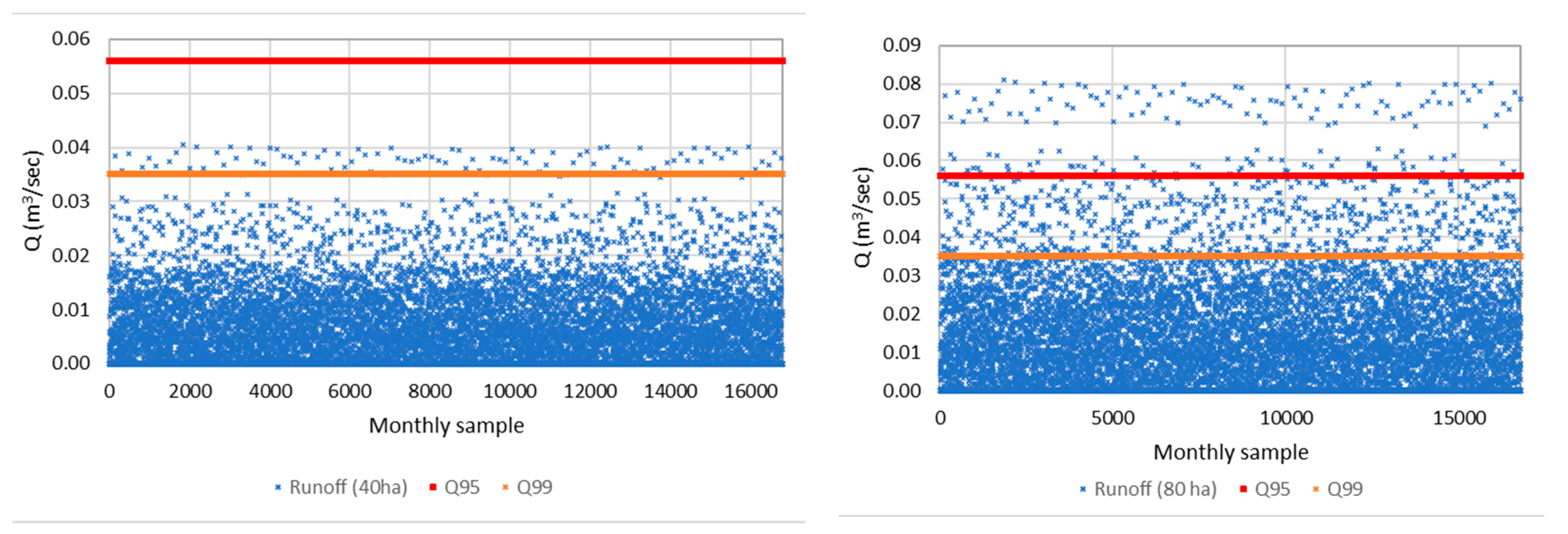
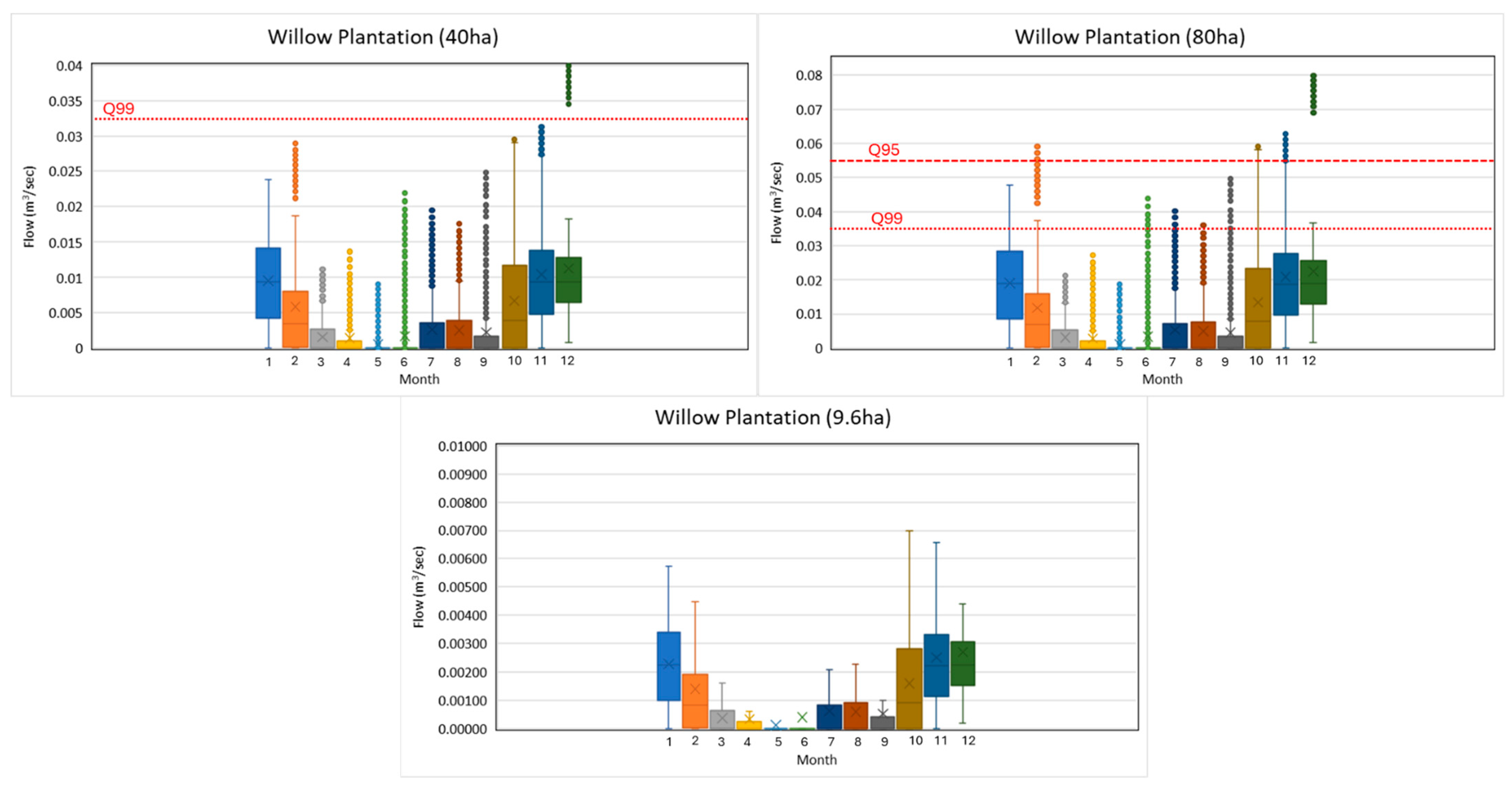
Disclaimer/Publisher’s Note: The statements, opinions and data contained in all publications are solely those of the individual author(s) and contributor(s) and not of MDPI and/or the editor(s). MDPI and/or the editor(s) disclaim responsibility for any injury to people or property resulting from any ideas, methods, instructions or products referred to in the content. |
© 2024 by the author. Licensee MDPI, Basel, Switzerland. This article is an open access article distributed under the terms and conditions of the Creative Commons Attribution (CC BY) license (https://creativecommons.org/licenses/by/4.0/).
Share and Cite
Tegos, A. A Monte Carlo Model for WWTP Effluent Flow Treatment through Enhanced Willow Evapotranspiration. Hydrology 2024, 11, 134. https://doi.org/10.3390/hydrology11090134
Tegos A. A Monte Carlo Model for WWTP Effluent Flow Treatment through Enhanced Willow Evapotranspiration. Hydrology. 2024; 11(9):134. https://doi.org/10.3390/hydrology11090134
Chicago/Turabian StyleTegos, Aristoteles. 2024. "A Monte Carlo Model for WWTP Effluent Flow Treatment through Enhanced Willow Evapotranspiration" Hydrology 11, no. 9: 134. https://doi.org/10.3390/hydrology11090134
APA StyleTegos, A. (2024). A Monte Carlo Model for WWTP Effluent Flow Treatment through Enhanced Willow Evapotranspiration. Hydrology, 11(9), 134. https://doi.org/10.3390/hydrology11090134




